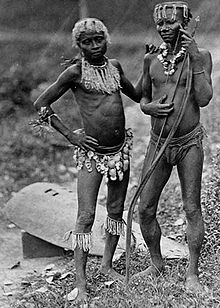Andaman
The Andamans are the indigenous people of the Andamans , divided into several ethnic groups , who are linguistically, culturally and also physically related to one another. It is widely believed that the Andaman people also colonized large parts of India before they were ousted by other peoples ( Dravids , Indo-Aryans and Munda ). They are counted among the Negrito to which they are genetically related.
origin
The Andamans are considered to be the original inhabitants of the Andaman Islands. They share their origins with other Negrito tribes in Southeast Asia as well as with Melanesians in Papua and Oceania .
According to genetic research, the Andamans, or a closely related group, were also native to India before slowly being ousted by other peoples. According to some genetic studies, today's Indians, especially the Adivasi , have some genomes from the Andamans. About 0% - 30% of the DNA of today's Indians can be traced back to the Andamans, whereby indigenous "Adivasi" groups have more Andamanian DNA.
Culture
The Andaman culture is based on hunter-gatherer principles and is similar to the cultures of other Negritos as well as some indigenous tribes in India.
religion
The Andamans follow an animistic religion that places great emphasis on ancestor worship .
groups
The four surviving ethnic groups are the Great Andamanese people , the Jarawa , the Onge and the completely isolated on North Sentinel Iceland living Sentinelese . India pledged to protect these people, and a law prohibits strangers from contacting them. All groups live extremely secluded. According to the Society for Threatened Peoples, the following were counted in 2006:
- 51 Great Andaman,
- 322 Jarawa,
- 99 Onge and
- 100 Sentinelese.
In 1974 the ethnologist Heinrich Harrer wrote, among other things, after visiting the islands
- Isolated on their island, the Sentinelese were able to preserve their originality .... Nobody knows their way of life or even their language.
- The Jarawa lead ... a semi-nomadic life in the forests of the west coast of Central and South Andaman.
- The Onge ... work ... in coconut plantations ..... The Indians chatted the men on penis cloth covers (and thus a hygiene problem) and plastic buckets and umbrellas as further progress tools.
- The Great Andamans ..., 4,000 a century ago, are only a small group of 23 lethargic people, have become incapable of fathering children and are poorly cared for by the Indians in a reservation.
literature
- Heinrich Harrer : "The last five hundred" Ullstein publishing house, Berlin
Web links
Individual evidence
- ↑ Analabha Basu, Neeta Sarkar-Roy, Partha P. Majumder: Genomic reconstruction of the history of extant populations of India reveals five distinct ancestral components and a complex structure . In: Proceedings of the National Academy of Sciences . tape 113 , no. 6 , February 9, 2016, ISSN 0027-8424 , p. 1594–1599 , doi : 10.1073 / pnas.1513197113 , PMID 26811443 ( pnas.org [accessed November 6, 2019]).
- ↑ Vasant Shinde, Vagheesh M. Narasimhan, Nadin Rohland, Swapan Mallick, Matthew Mah: An Ancient Harappan Genome Lacks Ancestry from Steppe Pastoralists or Iranian Farmers . In: Cell . tape 179 , no. 3 , October 17, 2019, ISSN 0092-8674 , p. 729–735.e10 , doi : 10.1016 / j.cell.2019.08.048 , PMID 31495572 ( cell.com [accessed November 6, 2019]).
- ↑ Vagheesh M. Narasimhan, Nick Patterson, Priya Moorjani, Nadin Rohland, Rebecca Bernardo: The formation of human populations in South and Central Asia . In: Science . tape 365 , no. 6457 , September 6, 2019, ISSN 0036-8075 , doi : 10.1126 / science.aat7487 , PMID 31488661 , PMC 6822619 (free full text).
- ^ AR Brown: The Religion of the Andaman Islanders . In: Folklore . tape 20 , no. 3 , 1909, ISSN 0015-587X , p. 257-271 , JSTOR : 1254079 .
- ↑ Archive link ( Memento from April 19, 2015 in the Internet Archive )
- ↑ Ethnology: People in the zoo . In: Der Spiegel . No. 32 , 1977 ( online - Aug. 1, 1977 ).
